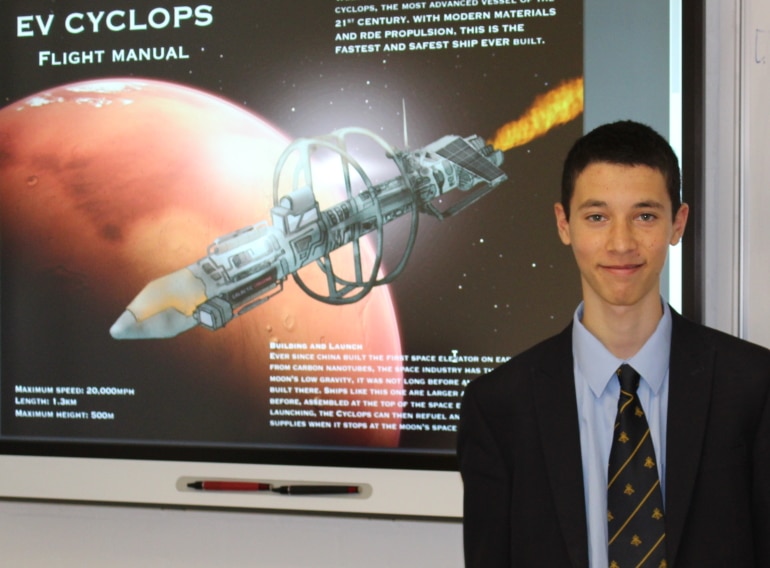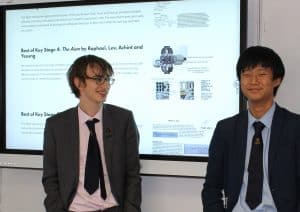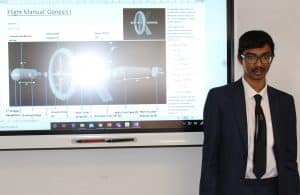
QE pupils, including both teams and individuals, have taken three of the top eight prizes in a summer competition to create a flight manual for astronauts travelling to Mars.
 Lev Shafran, Achint Thakkar and Ye-Sung Baek, who are now in Year 12, collectively won the Best of Key Stage 4 Award in the second stage of the Galactic Challenge Journey to Mars Digital Competition, together with a teammate from another school.
Lev Shafran, Achint Thakkar and Ye-Sung Baek, who are now in Year 12, collectively won the Best of Key Stage 4 Award in the second stage of the Galactic Challenge Journey to Mars Digital Competition, together with a teammate from another school.
The Science Award went to Medushan Thevadaran, also of Year 12, while the Illustration Award was won by Dylan Domb, pictured above, of Year 11. A further seven boys won gold awards, 15 took silver and six gained bronze.
Congratulating the winners, Head of Physics Jonathan Brooke said: “This was a popular competition among our boys, with 47 participants in 20 teams from Key Stage 3 through to Key Stage 5. It was an interesting challenge, requiring them to apply their skills in STEM [Science, Technology, Engineering, Mathematics] and to develop in areas such as teamwork, communication and leadership.
“There were also a few telling parallels between the challenges faced by astronauts confined to a spacecraft and those endured by the boys during lockdown.”
The competition to create the flight manual for a mission set in the year 2041 was the second stage of the competition – ‘Mission II’. QE boys also performed strongly in the first stage.
 Chair of the Galactic Challenge Aadil Kara, who is also an Old Elizabethan (OE 2010–2017), explained that when Covid-19 forced the cancellation of in-person events, including one due to be held at QE, the organisation had instead launched the digital competition to allow participants to enter from home.
Chair of the Galactic Challenge Aadil Kara, who is also an Old Elizabethan (OE 2010–2017), explained that when Covid-19 forced the cancellation of in-person events, including one due to be held at QE, the organisation had instead launched the digital competition to allow participants to enter from home.
For the Mission II manuals, pupils were asked to propose ideas to help the astronauts stay physically and mentally healthy in isolation. They were also tasked with designing the overall configuration of the spacecraft and with suggesting experiments to be conducted during the nine-month journey.
After a rigorous anonymised judging process, the winners were announced. In their feedback, the Digital Competition Team praised the:
- Use of floorplans by Key Stage 4 Award-winners Lev, Achint and Ye-Sung to show astronauts the location of facilities on their spacecraft, The Aion. with eight separate modules serving different purposes. “There was excellent consideration of backup resources, and the use of shifts amongst crew members was an interesting proposition.”
- “Real scientific principles” underpinning the manual for Science Award-winner Medushan’s Genesis I “Medushan referenced physical phenomena in lots of areas, including fuel used in the propulsion system, osmosis used in the water reclaimer, and dietary modifications for the astronauts to mitigate against radiation exposure.”
- “Impressive illustrations” from different elevations provided by the Illustration Award-winner, Dylan, for his Explorer Vessel Cyclops. “Dylan also used labelling and annotations throughout to bring the diagrams to life, explaining the purposes of all the components on the vehicle.”
Commenting afterwards from the Key Stage 4 Award-winning team, Lev said: “I am proud to have worked with such an outstanding team, and I would love to work with them again. I learnt both organising and entrepreneurial skills through the transitioning of a product into a specific format, and it has further inspired me to pursue my interest in astrophysics and aerospace engineering.” Achint said that not only was it a “rather interesting experience since it enabled me to research and predict the form that space travel might take 30 years into the future based on the technology which is growing right now and which might be useable sooner than people think” but it also required him to do some wider reading, which was good preparation for the A-level Physics he has now begun. Ye-Sung added: “I’m most proud of an element of the spacecraft that actually didn’t make it into the final submission, as we didn’t have time to put it in. It was a solenoid that would have blocked solar wind, ensuring the relative safety of those onboard.”
